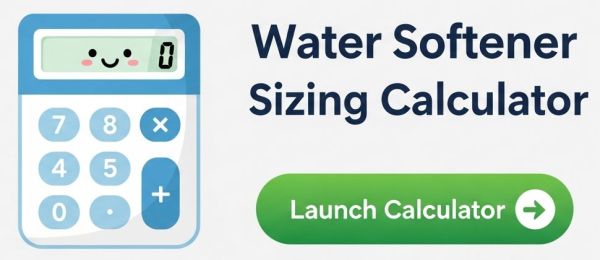What Size Water Softener Do I Need? A 5-Minute Sizing Guide
After I had my budget ready, I faced the final technical hurdle in solving my hard water problem: a wall of numbers: 24,000, 32,000, 48,000, 64,000… What on earth did these “grains” mean? I was terrified of making a mistake—buying a system too small that would waste salt, or one too big that would be a waste of money. It was then that I developed a simple formula that professionals use, one that removes all the guesswork. Today, I’m sharing it with you. Grab a pen and a calculator; in the next 5 minutes, you’ll know your perfect size.
The #1 Mistake Homeowners Make: Why Bigger Isn’t Better
Before we get to the math, we must debunk a dangerous myth that buying a bigger water softener “just in case” is a good idea. It’s not. When figuring out what size water softener you need, getting it “just right” is the only path to efficiency and long-term savings. Making a mistake in either direction is costly.
The Problem with Undersizing
Buying a system that’s too small for your needs means it will be constantly overwhelmed. It will need to regenerate far too frequently—sometimes every other day. This leads to a dramatic increase in salt and water consumption, negating any savings you hoped for. It’s like using a small window air conditioner to cool an entire house; it runs constantly, costs a fortune in electricity, and never truly gets the job done.
The Hidden Danger of Oversizing
This is the more counterintuitive mistake. An oversized system doesn’t regenerate often enough. Water can sit stagnant on the resin bed for too long, leading to a condition called “channeling,” where the water carves a single path through the resin, reducing its effectiveness. Furthermore, the resin bed may not be fully exhausted before a regeneration cycle, meaning the salt and water used to clean it are partially wasted. You’ve paid a premium for capacity you don’t use and can’t maintain efficiently.
Expert Takeaway: Proper water softener sizing is the key to efficiency. The goal is to have the system regenerate approximately once every 7 to 10 days. This schedule ensures the resin bed is used effectively without wasting resources or risking damage.
The 2 Critical Numbers You MUST Know Before Sizing
The entire calculation hinges on two simple pieces of data about your home. You must have these numbers.
Number 1: Your Home’s Water Hardness (in GPG)
This is the measure of mineral concentration in your water. If you don’t have this number, you are flying blind. You must get this value before you spend a single dollar.
In our previous guide, we covered the three ways to get this number, from DIY test kits to lab analysis. The most reliable home method is a titration (drop) test kit, which will give you a precise GPG value.
Read my complete guide to testing your water here »Number 2: Your Daily Water Usage (in Gallons)
This is the total amount of water your household uses each day. There are two ways to determine this:
The Easy Way (Estimate): The national average, according to the EPA, is about 75 gallons per person, per day. Simply multiply the number of people in your home by 75.
(Number of People) x 75 Gallons = Your Daily Usage
Example for a family of 4: 4 people x 75 gallons = 300 gallons per day.
The Pro Way (Measure): For a more precise figure, check your water bill, which may show your average daily usage. Or, read your water meter before you go to bed and again at the same time the next night to see your exact 24-hour consumption.
The Pro’s Formula: Calculating What Size Water Softener You Need
With your two numbers in hand, you’re ready to perform the exact calculation a professional would use. Let’s walk through it with an example for a family of 4 with a water hardness of 15 GPG.
Step 1 Calculate Daily Grains
First, we calculate your home’s daily softening requirement. This is the total number of grains of hardness your softener needs to remove every single day.
(Gallons Used Daily) x (Hardness in GPG) = Grains Per Day
Our Example:
300 Gallons x 15 GPG = 4,500 Grains per Day
Step 2 Determine Weekly Load
Next, we determine the total load the softener must handle between regenerations. Since the ideal schedule is about once a week, we multiply the daily requirement by 7 days.
(Grains Per Day) x 7 Days = Required Capacity
Our Example:
4,500 Grains/Day x 7 Days = 31,500 Grains
Step 3 Choose the Right System Size
Finally, you choose a system with a grain capacity that is equal to or, more commonly, the next size up from your required capacity. Water softeners are sold in standard sizes.
Required Capacity → Next Standard Size Up
Our Example:
Our required capacity is 31,500 grains. The next standard size up is a 32,000-grain water softener. This is the perfect size.
Water Softener Sizing Calculator
Enter your water hardness and the number of people in your household to find the right softener size for your needs.
You can usually find this number on your local water quality report. 1 GPG is equivalent to 17.1 mg/L.
Recommended Size
For your household, we recommend a water softener with a capacity of approximately: (grains)
Please enter valid numbers for water hardness and people.
What Do These Numbers Mean?
The calculated value is the "grains capacity" of the softener. This is the total amount of hardness grains the system can remove before it needs to regenerate (clean itself). The higher the number, the longer the softener will operate between regeneration cycles.
An Important Note on Iron
This calculator is designed for sizing a softener to remove water hardness. If your water also contains iron, it is highly recommended to install a dedicated iron filter before the water softener to protect the softener resin and ensure optimal performance.
How the Calculation Works
The total grain capacity needed is calculated based on your household's weekly water softening demand, plus a safety buffer.
Daily Grains = (People x Gallons/Day) x Hardness (GPG)
Required Capacity = (Daily Grains x 7 Days) x 1.25 Safety Factor
This calculator uses the following industry-standard values for its formula:
- Average water usage: 80 gallons per person per day.
- Regeneration cycle: 7 days.
- Safety factor: 1.25 (25%) to handle peak usage.
Water Softener Sizing Chart (Quick Reference)
For a quick estimate, this chart shows common recommendations for a family of four based on different water hardness levels.
| Water Hardness Level (GPG) | Example City | Calculated Need (for 4 people) | Recommended System Size |
|---|---|---|---|
| 5 GPG (Slightly Hard) | New York City, NY | 10,500 Grains | 24,000 Grain |
| 10 GPG (Moderately Hard) | Chicago, IL | 21,000 Grains | 24,000 or 32,000 Grain |
| 15 GPG (Hard) | Los Angeles, CA | 31,500 Grains | 32,000 Grain |
| 20 GPG (Very Hard) | Phoenix, AZ | 42,000 Grains | 48,000 Grain |
| 30+ GPG (Extremely Hard) | Parts of Texas & Midwest | 63,000+ Grains | 64,000 or 80,000 Grain |
Special Considerations: Well Water, Iron, and Large Families
The formula above is perfect for most city water situations. However, certain factors require you to adjust your calculations, typically by choosing a system that’s one size larger than what the formula suggests.
- Well Water: Well water is often harder and can contain sediment. Sizing up provides a buffer and ensures the system isn’t overworked.
- Iron Content: If your water test shows the presence of iron (even 1-2 PPM), it will exhaust the softener’s resin much faster than hardness minerals. You MUST size up. For every 1 PPM of iron, treat it as an additional 4 GPG of hardness in your calculation.
- Large Families (6+ people): For larger households, your daily water usage is much higher. It’s often more efficient to choose a larger system (e.g., 64,000 grain) that can go longer between regenerations than a 48,000-grain unit that has to regenerate every few days.
Frequently Asked Questions About Sizing

You Have Your Number. Now What?
You are no longer guessing about what size water softener you need. You’ve moved from the confusing world of marketing terms to the clarity of engineering. You know the technology you need, you have a budget, and now you have the exact, calculated size required to solve your hard water problem efficiently and economically.
Before we dive into the final step of choosing a specific model, there’s one more piece of the puzzle: restoring your home from the damage that’s already been done. Let’s get a quick win and make your home sparkle again.

